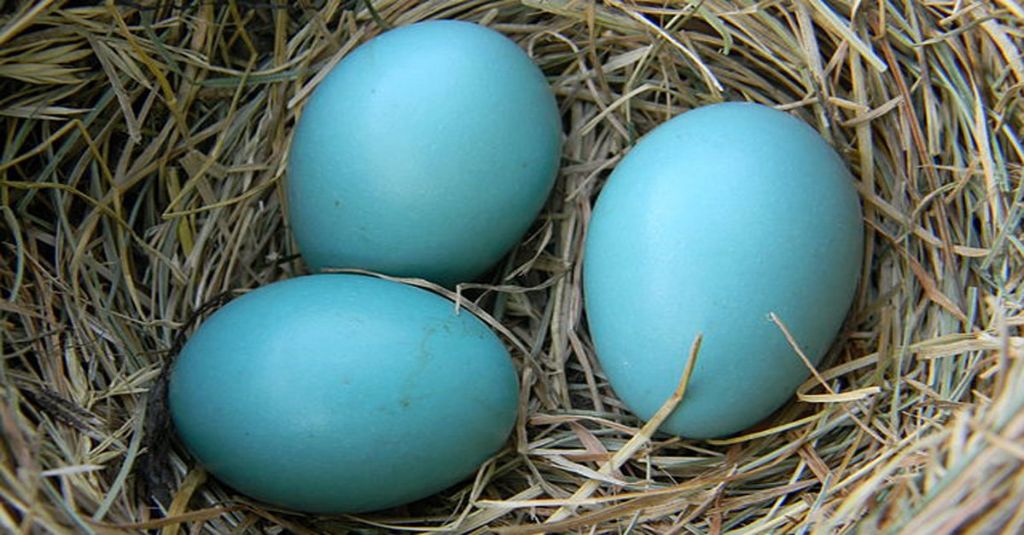Why Are Robins Eggs Blue?
The robin is one of the most beloved and recognizable birds in North America. With its cheery red-orange breast and sweet song, it heralds the arrival of spring. But the robin has a distinctive feature that many people wonder about – its beautiful blue eggs. Unlike many other birds that lay eggs in muted colors like white, tan or green, the robin’s eggs are a striking shade of blue.
The robin’s blue eggs stand out against the nest, catching our eye. This unique color begs the question – why are robin eggs blue? The robin belongs to a group of birds where blue or blue-green eggs are the norm. But scientists have debated the evolutionary reason behind this vivid egg color. Examining robin nesting behaviors and the advantages of their blue eggs can help uncover the mystery behind this eye-catching shade.
Origin of the Robin
The Robin (scientific name: Turdus migratorius) is part of the thrush family and is native to North America. The species likely originated during the mid-Pleistocene and has since spread across the continent.
According to the Audubon Society, the Robin is found in many diverse habitats ranging from parks, gardens, and woodland edges to mountain forests. They can survive in a variety of climates from southern Canada down to central Mexico. Robins often migrate in the winter to avoid harsh cold weather and find more abundant food sources.
Evidence shows Robins were present in the Americas well before European settlement. Fossil records date back to the Illinoian glacial period over 300,000 years ago. Early American settlers named the bird the Robin because of its reddish-orange breast which resembled the European Robin they were familiar with. However, the two species are not closely related.
Today, the American Robin remains widespread and common. Its global population is estimated at over 320 million. Robins have proven highly adaptable to human activity and urbanization. They are a familiar backyard sight across much of the United States.
Robin Nesting Behavior
Nesting behavior for robins is quite adaptive and flexible. According to All About Birds, robins build their nests out of grasses, twigs, mud, and sometimes even paper or cloth see source. They tend to place their nests in protected spots, building them on branches in trees, bushes, or vines, but are also known to build nests in other structures including gutters, doorframes, and eaves See source. Robins often choose surfaces that provide adequate support for their nest structures. The placement of robins’ nests varies by climate and the available options in a given area.
Number of Eggs
Female robins typically lay a clutch of 3-5 eggs, laying one egg per day (Source 1). They only use one working ovary to produce eggs, unlike mammals which have two ovaries. This limits robins to producing just one egg per day. Laying one egg per day over several days allows the female robin to conserve resources and ensure each egg has the proper nutrients and care (Source 2).
Once the female robin has laid her full clutch, she will start incubating them. The eggs hatch in about 2 weeks from when incubation starts.
Robin Egg Color
Robins lay eggs that are a uniform pale blue color with no spots or markings (Hitchcock Center). This light blue hue is unique among songbirds and is known as “robin egg blue” in reference to the American robin (Wikipedia). The eggs have an immaculate appearance with a consistent blue-green teal color across the entire surface.
The robin egg color is notable for its pale, unspeckled nature compared to the brown-spotted eggs of many other bird species. While the evolutionary reasons are still debated, the robin’s blue egg color likely plays an important role in camouflage, egg recognition, and visual signaling.
Theories on Blue Color
There are several theories as to why robins and other bird species lay blue eggs. One prevalent theory is that the blue color provides camouflage and helps the eggs blend in with the sky, providing protection from predators. The pale blue color is thought to be difficult for predators to spot when a mother robin is away from the nest. This protects the eggs from being eaten.

Some research also suggests that the intensity of blue-green egg color indicates the quality of the male robin. Males contribute to egg color through their genetic material. Therefore, more vibrant blue-green eggs may signal a fitter, higher quality male. This blue-green coloring may have evolved through sexual selection as an honest indicator of male quality (1).
Additionally, studies show the biliverdin pigment that produces the blue-green hue enhances the strength and thickness of the eggshell. The extra calcium in blue-green eggs makes them harder to crack open. This structural integrity provides even more protection from predation (2).
Light and Pigment
The blue color of robin eggs is due to a combination of pigment and how light interacts with the egg shell. The underlying pigment in robin eggs is biliverdin, which is a green bile pigment found in bird eggs. Biliverdin is deposited on eggshells when the female robin lays the eggs (Source).
On top of the biliverdin layer is a second layer of calcium carbonate. This outer layer scatters the light waves, causing the green biliverdin underneath to be perceived as blue. Essentially, the biliverdin pigment selectively absorbs red and orange light, while the calcium carbonate layer scatters the blue light waves, resulting in the striking blue color of robin eggs (Source).
Evolutionary Advantages of Blue Robin Eggs
Research suggests the blue color of robin eggs may have conferred evolutionary advantages that increased the reproductive success and survival of blue-egg-laying robins over time.[1]
One theory is that the blue color made robin eggs more difficult for predators to spot in the nest, offering camouflage. This would have decreased predation on robin eggs and given blue-egg-laying robins a higher chance of successfully hatching their young.[2]
Another idea is that the blue color helped robin parents identify their own eggs in the nest, reducing the chance of accidentally rejecting one of their own eggs. This improved hatching success and reproductive fitness.
Over many generations, as blue-egg-laying robins produced more offspring that survived to reproduce, the blue egg trait became widespread throughout robin populations.
While the exact evolutionary mechanism is still debated, most evidence indicates the striking blue color of robin eggs was advantageous in robins’ natural environments and reproductive strategies.
[1] https://www.forbes.com/sites/grrlscientist/2016/07/25/why-are-robins-eggs-blue/
[2] https://www.hitchcockcenter.org/earth-matters/cracking-the-mystery-of-how-birds-eggs-are-blue/
Comparison to Other Species
There is a correlation between egg color and bird size, with blue eggs being more common in smaller species while larger birds tend to lay brown or white eggs.
Small songbirds like robins, bluebirds, and finches typically lay blue or blue-green eggs. The blue egg color provides camouflage in the nest and may have other advantages related to egg strength and sun exposure. Small birds are more vulnerable in open nests, so the blue egg color helps hide the eggs when the adult bird is away.
Larger birds like chickens, ducks, and geese usually lay brown or white eggs which blend in with their surroundings. Being larger birds, their nests are less vulnerable, so the egg color does not need to provide as much camouflage. Additionally, larger birds tend to have thicker shells so the strength benefits of blue eggs are less pronounced.
So while many songbirds lay blue eggs, larger species tend to have brown or white eggs. The blue egg color provides advantages for smaller open-nesting birds while large bird eggs rely less on camouflage or strength benefits.
Sources:
https://www.birdsandblooms.com/birding/attracting-birds/bird-nesting/identify-bird-eggs/
https://www.woodlandtrust.org.uk/blog/2020/05/identify-eggshells/
Conclusion
In summary, the mystery behind why robin eggs are blue comes down to several key factors. Robin eggs contain biliverdin, a blue pigment that filters light and likely helps camouflage nests. The color also signals male fertility and female health. While the exact evolutionary advantage remains unclear, blue is the most common egg color for open-nesting birds. Robin eggs aren’t unique in this regard, but their bright blue hue certainly stands out.
There are still unanswered questions around why some robin eggs are paler or more greenish. Research is ongoing into how genetics, environment, and diet influence egg color. We also don’t fully understand how the blue pigment itself forms or why some species have red and brown eggs. The diversity of egg colors in the avian world shows there are complex biological processes at play.
“The whitish robin’s egg is a marvel of physics, chemistry, biology, and engineering. It shows that shadowy blue has multiple meanings.” – David Quammen


